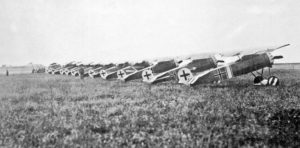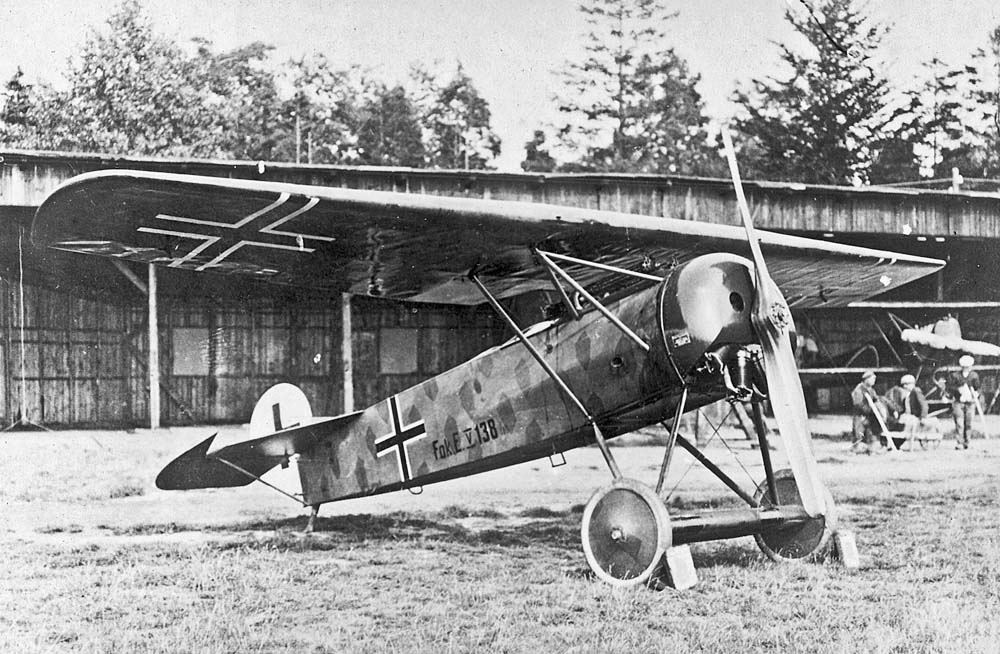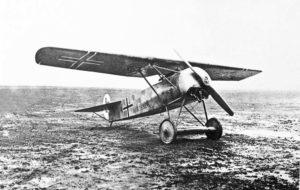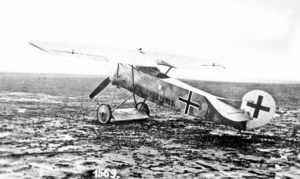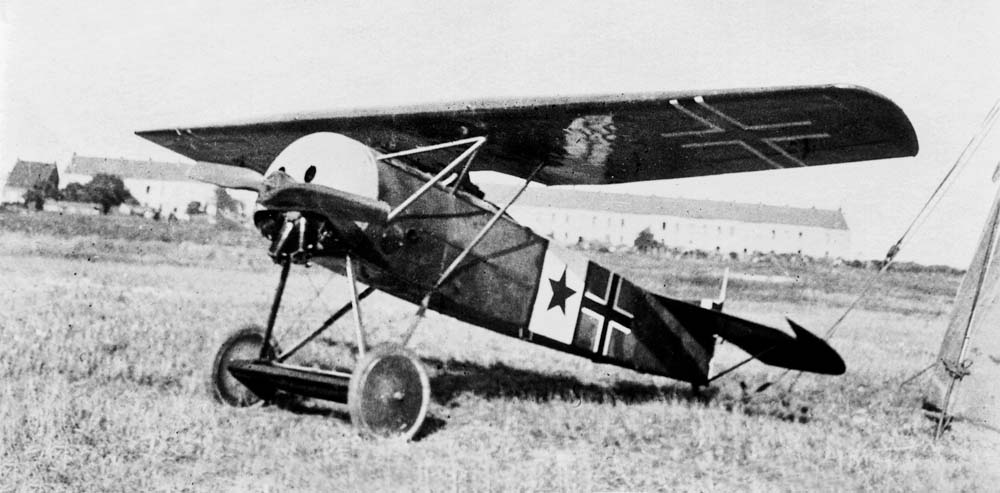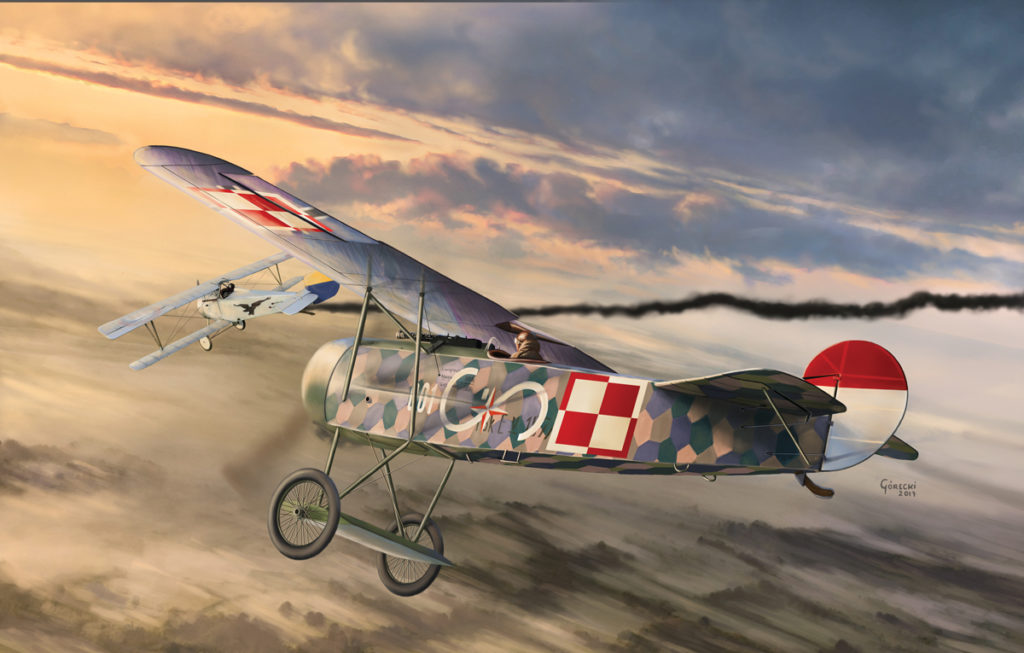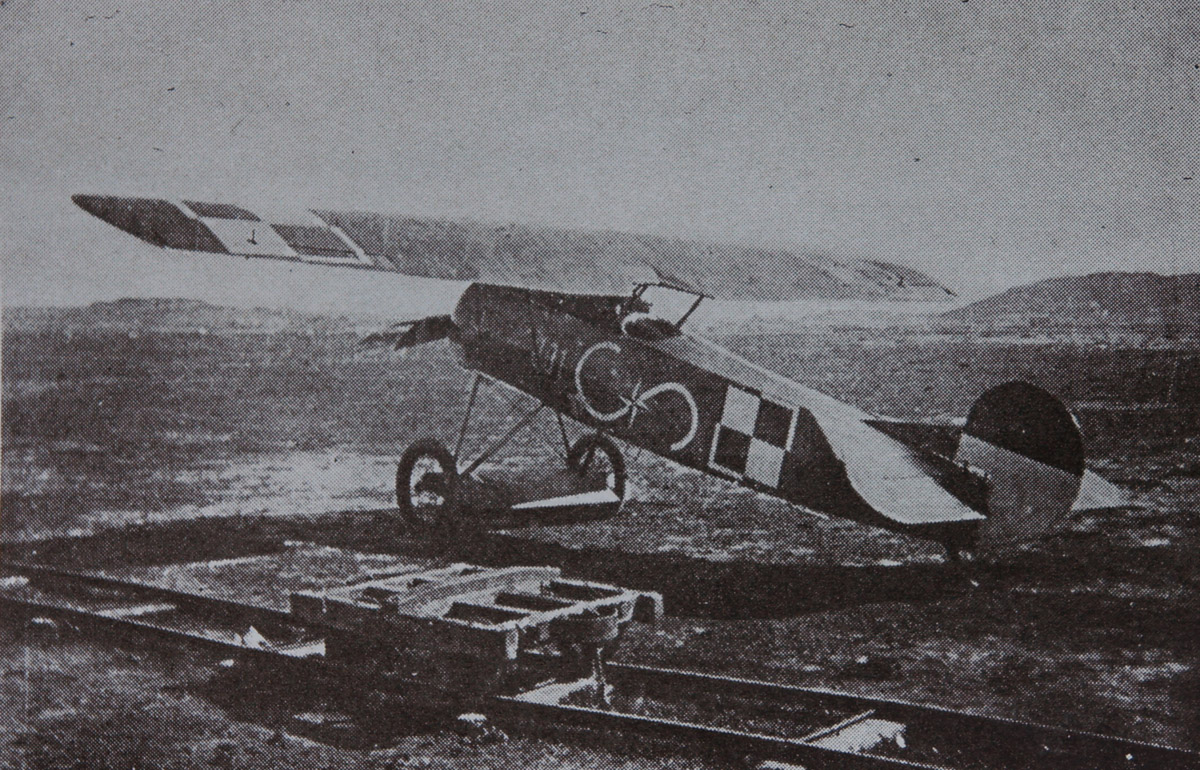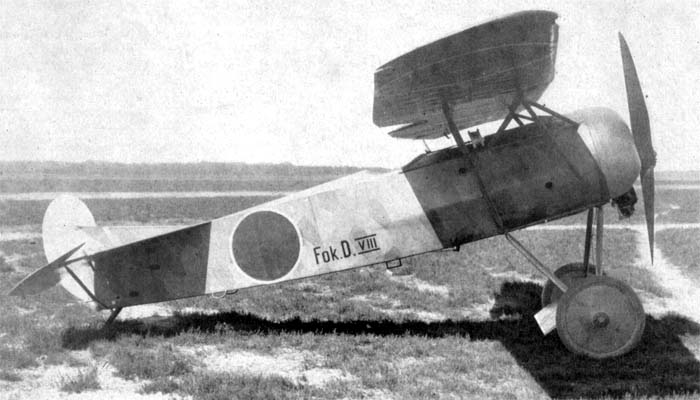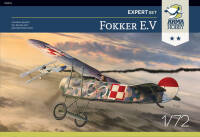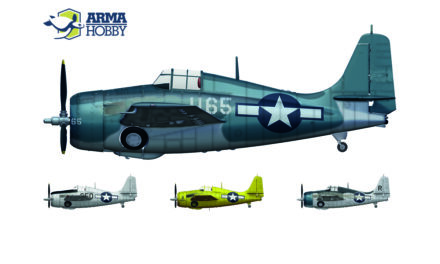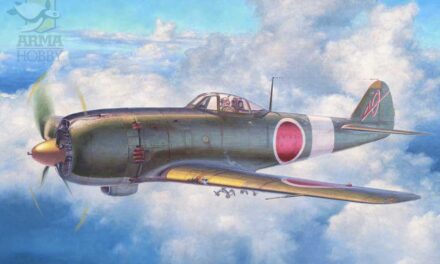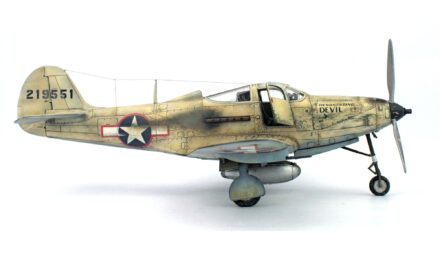The aim of the Second Fighter Contest, convened at the Adlershof German aircraft test centre during May and June 1918, was to choose new airplanes for the Kaiser’s air forces. Unquestioned winner of the rotary engine-powered category was the Fokker E.V streamlined monoplane with innovative plywood-covered wing. It was the logical development of the long Anthony Fokker’s line of successful fighter airplanes. The E.V had welded steel-tube fuselage construction typical for all previous Fokkers and powerplant design unchanged since E.I: very light, but relatively weak rotary engine. Thick airfoil, inspired by Fokker’s short cooperation with prof. Hugo Junkers, made the wing strong and aerodynamically very efficient. It was successfully applied already in Dr.I triplane and D.VI and D.VII biplanes.
 Fokker E.V of Jasta 6. Photo via Jack Herris
Fokker E.V of Jasta 6. Photo via Jack Herris
The most important innovation in E.V was the wing construction: fully cantilever, all-wood, with smooth plywood covering. Such lightweight design, tested in some earlier experimental airframes, allowed for production of the high-performance fighter even with not very strong rotary engine. After the war, such construction became worldwide standard (used eg. in famous commercial Fokker F.VII Trimotor) until the advent of the all-metal stressed skin airframes.
Fokker Jasta 6 line-up. Bernes airfield, August 1918. Photo via Jack Herris
Rise and fall in Flanders
First production Fokkers E.V arrived in the frontline units on 5 August 1918 – just before the great Entente Amiens Counteroffensive. Jasta 6 (Jagdstaffel – Fighter Squadron) from the elite Richthoffen’s Jagdgruppe I (Fighter Group) was the first unit which got these airplanes. In the following days Fokkers reached numerous other units of the Army: Jasta 1, 8, 19, 24, 36 and Navy: Marine Feld Jasta I, II, III and Seefrosta (See Front Staffel – Naval Front Squadron).
Factory-fresh Fokker 138/18 delivered to the Marine Feld Jasta, August 1918. Photo via Jack Herris
Pilots were initially very impressed with airplane performance, even despite minor technical problems: most often emergency landings caused by the engine malfunction due to low quality of Voltol – castor oil low quality ersatz. Unfortunately, after less than two weeks more serious troubles came: on 16 and 19 August two planes from the Jasta 6 have lost its wings in flight and crashed, killing the pilots. As very similar crashes – caused by faulty production –had happened in 1917 Autumn to the initial series Fokker Dr.I triplanes, the Command has immediately grounded remaining Fokkers E.V pending thorough investigation. 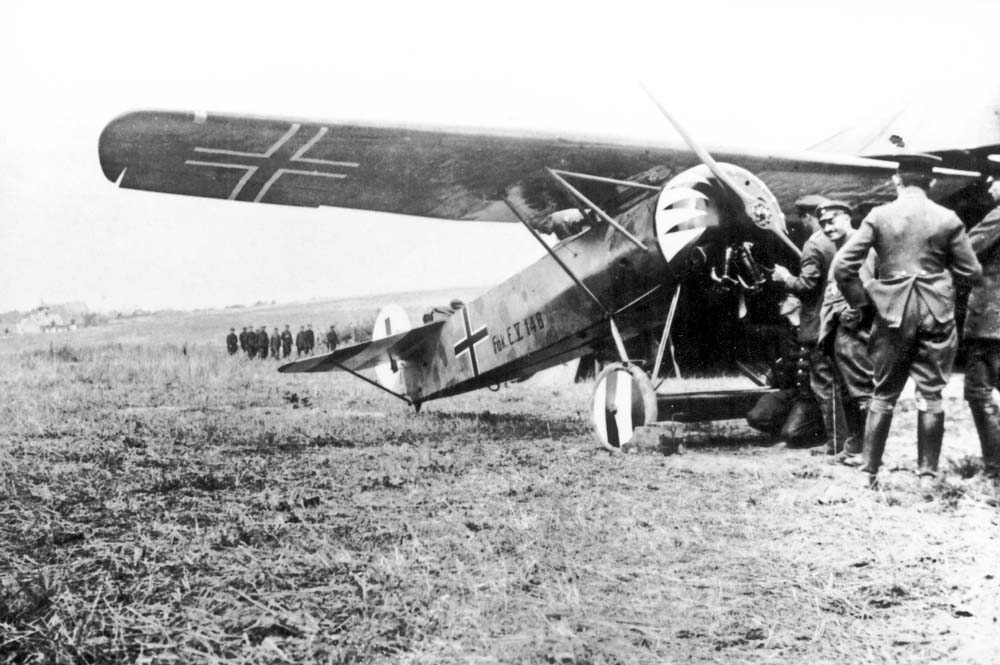 Fokker E.V 148/18 z Jasta 6. Fot. via Jack Herris
Fokker E.V 148/18 z Jasta 6. Fot. via Jack Herris
Before that only one aerial victory achieved by the pilot flying E.V has been recorded. It was a Sopwith Camel from the Squadron 203, shot down on 17 August by, ironically, the same Lt. Emil Rolff of Jasta 6 who has been killed two days later in second Fokker E.V fatal crash which finally caused the type grounding. While the Naval units ignored the ban for a few following days, even their best aces like Gotthard Sachsenberg and Theodor Osterkamp were not able to score any more victory. Still the pilots who flew Fokker E.V operationally praised the type very high, considering them the most modern and advanced fighters of the Kaiser’s aviation, pointing as a problem only a relatively low speed at highest altitudes, caused by the weak rotary engine. Entente pilots had E.V in very high respect too, nicknaming it “Fokker’s Razor”.
Fokker 553/18 with reinforced wing, after type redesignation as D.VIII Photo via Jack Herris
During the investigation Military Comission has found several serious problems with production quality at one of the Fokker subcontractors, pre-war piano producer Perzina factory. Most important was the improper spar dimension and faulty assembly. Authorities have ordered replacement of the wings of all the airplanes already produced. Improved airframe has been redesignated as Fokker D.VIII. In order to convince the pilots that the wings are really safe and strong, creative Anthony Fokker has ordered a photo-session on the Jasta 19 airfield, showing 24(!) men standing on the airplane wing!
Publicity photo ordered as a proof of the structural durability of the Fokker’s wing. Photo via Jack Herris
All these actions remained relatively futile, as soon after the return of the “Razors” to the units in 1918 Autumn all frontline activity has stopped due to the Armistice. Fokkers D.VIII were yet able to fly in German colours a few more months in clandestine Jasta Döberitz and in Kampfgeschwader Sachsenberg fighting against Bolshevik in Latvia, but effectively on November 1918 the German military aviation ceased to exist for over 15 years.
Red star-marked Fokker E.V of Jasta 36. Summer 1918. Photo via Jack Herris
Success in Polish colours
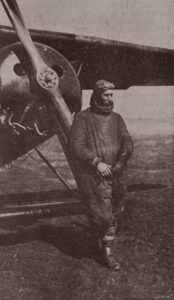 Relatively the most active frontline user of the Fokkers E.V/D.VIII was Poland. 17 examples, mostly captured during Wielkopolskie Uprising in winter 1918/1919, have been quickly assembled and some – through Warsaw – were sent to the front. Single planes were assigned to several squadrons (9, 12, 15 and 19), but the fame and glory these fighters gained thanks to participation in fights against Ukrainians over city of Lwów – on strength of the 7. Eskadra Lotnicza (Flying Squadron), later joined by American volunteers and known as “Kosciuszko Squadron”. These planes were piloted by two Polish popular heroes, veterans of the the Great War in the Austro-Hungarian service, kpt. Stefan Bastyr and por. Stefan Stec – the latter famous also as a designer of the white-and-red checkerboard, initially his personal marking, which soon became official Polish air force national insignia used till nowadays.
Relatively the most active frontline user of the Fokkers E.V/D.VIII was Poland. 17 examples, mostly captured during Wielkopolskie Uprising in winter 1918/1919, have been quickly assembled and some – through Warsaw – were sent to the front. Single planes were assigned to several squadrons (9, 12, 15 and 19), but the fame and glory these fighters gained thanks to participation in fights against Ukrainians over city of Lwów – on strength of the 7. Eskadra Lotnicza (Flying Squadron), later joined by American volunteers and known as “Kosciuszko Squadron”. These planes were piloted by two Polish popular heroes, veterans of the the Great War in the Austro-Hungarian service, kpt. Stefan Bastyr and por. Stefan Stec – the latter famous also as a designer of the white-and-red checkerboard, initially his personal marking, which soon became official Polish air force national insignia used till nowadays.
Por. Stefan Stec in front of his Fokker E.V “001” Lwów, Spring 1919. Photo: National Library of Poland/POLONA.PL
Polish-Ukrainian War conditions gave few opportunities for dogfights. Polish Fokkers were so much respected that Ukrainians and Austrian mercenaries flying in Ukrainian colours rarely flew over the city of Lwów. Despite the fact that Poles often performed many missions a day, mostly patrolling and ground attacks, only one real fighter’s duel has been fought. On the 29 April 1919 morning, when the Ukrainian reconaissance Brandenburg C.I had been attacked and repelled by Stec’s Fokker, the skirmish has been joined by the Ukrainian Nieuport piloted by the Austro-Hungarian 11-victories ace Franz Rudorfer. After several minutes of the struggle, observed from the ground by many Polish soldiers and civilians, Stec severely hit the enemy Nieuport forcing it to retreat. Despite fact that Rudorfer has been able to hide in the fog and reached home airfield, numerous witnesses considered Ukrainian plane shot down. Stec himself reported only damaging the enemy. A few days later Rudorfer, probably impressed with Polish aviation effectiveness, has hijacked his airplane and defected to Czechoslovakia.
Aerial duel of por Stefan Stec vs Franz Rudorfer , 29th April 1919, Defence of Lwów. Artowork by Marcin Górecki.
Polish Fokkers later flew many effective ground attack missions during Polish offensive started in early May. There was another, but at that time inconclusive, dogfight against Ukrainian Nieuport and several brave attacks against heavily-defended observation balloons. While every time Polish pilots managed to force the enemy to pull the balloon down, they were not able to finally destroy it. After 14 May the front went more than 100 km to the East so the short-ranged Fokkers were not able to effectively operate from Lwów airbase. In such situation the Command decided to honour the 7. Eskadra with reorganization from general-purpose into purely fighter unit, and rearm it exclusively with factory-fresh Albatros-Oeffag D.III airplanes imported from Austria.
Stefan Stec’s Fokker E.V “001” Lwów, Spring 1919. Photo: National Library of Poland/POLONA.PL
Single Fokkers E.V were used against Soviets till 1920 – one of them, piloted by young and inexperienced por. Julian Jasiński lost his way flying from Warsaw to frontline airfield of 19. Eskadra. Pilot has finally landed in Slavnoye – airbase of the Soviet fighter group led by ace Grigory Shirinkin and the captured airplane has been later used by Soviets. The only Polish Fokker modified to D.VIII standard fought during the most intensive days of the defence of Lwów against Budenny Konarmia (Horse Army). After the end of the hostilities Fokkers, as well-performing and interesting-looking airplane were intensively used in training and during several shows and exhibitions.
 Kpt. Stefan Bastyr’s Fokker E.V “002” Lwów, Spring 1919. Photo: National Library of Poland/POLONA.PL
Kpt. Stefan Bastyr’s Fokker E.V “002” Lwów, Spring 1919. Photo: National Library of Poland/POLONA.PL
Other users of the Fokker D.VIII
Anthony Fokker, being Dutch citizen, just before the end of the Great War managed to smuggle equipment of his factory and numerous finished airframes from defeated Germany to Netherlands. Several Fokkers D.VIII had been “saved” this way and many of them, with the German crosses overpainted with orange discs similar to Japanese Hinomaru were sold to the Netherlands aviation. Victorious Entente countries were eager to test the famous “Razors” too – Belgians, Americans, Italians… After military testing, many Fokkers were sold to civilian users and used as training, aerobatic, stunt and fast mail airplanes. Even Soviet elite 10 Aviaotriad (Aviation Unit) has used at least one Fokker, ex-Polish captured machine, tested also with skies instead of wheels.
Dutch Fokker D.VIII. Fot. Wikipedia
Advertisement
Check out our plastic Fokker E.V. model kits in armahobby.com
Modeller, son and father of a modeller. Loves digging through references and analysing old photographs. He builds aircraft, ship and vehicle models, the older the better. He has a weakness for Polish equipment, but does not despise the RAF, FAA and Great War topics. A journalist by training.
This post is also available in:
 polski
polski



